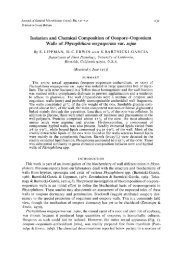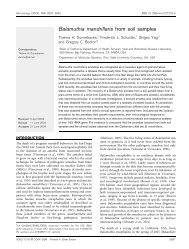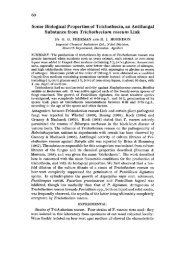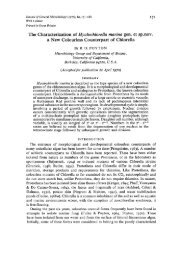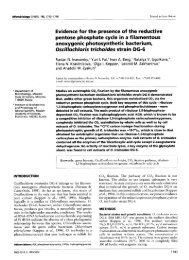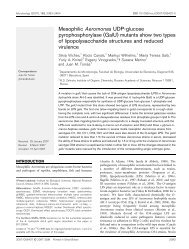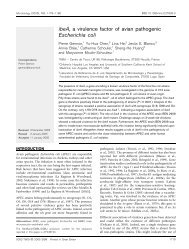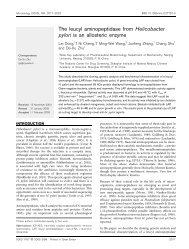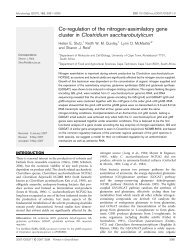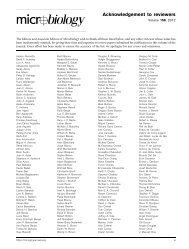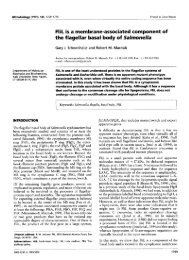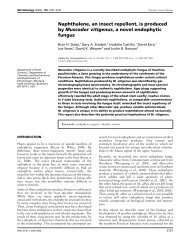Nitrate-responsive NarX-NarL represses arginine ... - Microbiology
Nitrate-responsive NarX-NarL represses arginine ... - Microbiology
Nitrate-responsive NarX-NarL represses arginine ... - Microbiology
Create successful ePaper yourself
Turn your PDF publications into a flip-book with our unique Google optimized e-Paper software.
<strong>Microbiology</strong> (2008), 154, 3053–3060 DOI 10.1099/mic.0.2008/018929-0<br />
Correspondence<br />
Max Schobert<br />
m.schobert@tu-bs.de<br />
Received 28 March 2008<br />
Revised 11 June 2008<br />
Accepted 18 June 2008<br />
INTRODUCTION<br />
In Pseudomonas aeruginosa anaerobic metabolism is<br />
important for biofilm growth and for the infection of the<br />
cystic fibrosis lung involving biofilm-like P. aeruginosa<br />
microcolonies (Barraud et al., 2006; Filiatrault et al., 2006;<br />
Hassett et al., 2002; Palmer et al., 2007; Platt et al., 2008;<br />
Sauer et al., 2002; Van Alst et al., 2007; Worlitzsch et al.,<br />
2002; Xu et al., 1998). In the absence of oxygen P.<br />
aeruginosa grows either by denitrification or by <strong>arginine</strong><br />
fermentation (Carlson & Ingraham, 1983; Vander Wauven<br />
et al., 1984; Zumft, 1997). The expression of genes which<br />
encode enzymes for denitrification in P. aeruginosa are<br />
controlled by the regulatory proteins Anr and Dnr, as well<br />
as the nitrate-<strong>responsive</strong> two-component system <strong>NarX</strong>-<br />
<strong>NarL</strong> (Arai et al., 1997; Schreiber et al., 2007; Ye et al.,<br />
1995). Enzymes required for <strong>arginine</strong> fermentation are<br />
encoded by genes which are organized in the operon<br />
arcDABC (Luthi et al., 1990). Anaerobic expression of<br />
arcDABC has been shown to be Anr-dependent and further<br />
3Present address: Institute of Biochemistry and Biotechnology,<br />
Technical University Braunschweig, Spielmannstr. 7, D-38106<br />
Braunschweig, Germany.<br />
Abbreviations: MU, Miller units; RuBPS, ruthenium(II)-tris(bathophenanthroline<br />
disulfonate).<br />
<strong>Nitrate</strong>-<strong>responsive</strong> <strong>NarX</strong>-<strong>NarL</strong> <strong>represses</strong> <strong>arginine</strong>mediated<br />
induction of the Pseudomonas<br />
aeruginosa <strong>arginine</strong> fermentation arcDABC operon<br />
Beatrice Benkert, 1 Nicole Quäck, 1 Kerstin Schreiber, 1 3 Lothar Jaensch, 2<br />
Dieter Jahn 1 and Max Schobert 1<br />
1<br />
Institute of <strong>Microbiology</strong>, Technical University Braunschweig, Spielmannstr. 7, D-38106<br />
Braunschweig, Germany<br />
2 Division of Cell and Immune Biology, Proteome Research Group, Helmholtz Centre for Infection<br />
Research, Inhoffenstr. 7, D-38124 Braunschweig, Germany<br />
Denitrification and <strong>arginine</strong> fermentation are major parts of the anaerobic metabolism of<br />
Pseudomonas aeruginosa, which is important for biofilm formation and infection. The twocomponent<br />
regulatory system <strong>NarX</strong>-<strong>NarL</strong> is part of the underlying network and is required for<br />
denitrifying growth. All target promoters identified so far are activated by <strong>NarL</strong>. In this study the<br />
effect of <strong>NarL</strong> on <strong>arginine</strong> fermentation was investigated using proteome, Northern blot and lacZ<br />
reporter gene analyses. <strong>NarL</strong>-dependent repression of the arcDABC operon was observed and<br />
the corresponding <strong>NarL</strong>-binding site in the arcD promoter region was functionally localized at<br />
”60 bp upstream of the transcriptional start site using site-directed promoter mutagenesis and<br />
reporter gene fusion experiments. The results clearly show that in the presence of nitrate <strong>NarL</strong><br />
<strong>represses</strong> the <strong>arginine</strong>-dependent activation of the arcDABC operon mediated by ArgR. It does<br />
not influence the oxygen-tension-dependent activation via Anr. Thus, the anaerobic energy<br />
metabolism of P. aeruginosa is coordinated via <strong>NarX</strong>-<strong>NarL</strong> activity. In the presence of nitrate the<br />
highly efficient denitrification is preferred over the less attractive <strong>arginine</strong> fermentation.<br />
stimulated by the <strong>arginine</strong>-<strong>responsive</strong> regulator ArgR (Lu<br />
et al., 1999). The global oxygen-sensing regulator Anr is an<br />
Escherichia coli Fnr homologue and is essential for<br />
fermentative and denitrifying growth in the absence of<br />
oxygen (Ye et al., 1995). Moreover, Anr controls the<br />
expression of dnr, which encodes the nitrogen-oxidesensing<br />
regulator Dnr (Arai et al., 1997). Dnr finally<br />
induces expression of the genes encoding the nitrite, nitric<br />
oxide and nitrous oxide reductases required for denitrification<br />
(Arai et al., 1999, 2003). Mutant and gene<br />
expression studies in P. aeruginosa and Pseudomonas<br />
stutzeri showed that the two-component system <strong>NarX</strong>-<br />
<strong>NarL</strong> is additionally required for denitrifying growth<br />
(Härtig et al., 1999; Schreiber et al., 2007). The P.<br />
aeruginosa <strong>NarX</strong> protein is a sensor kinase and shares<br />
38 % and 34 % sequence identity with <strong>NarX</strong> from P.<br />
stutzeri and E. coli, respectively (Härtig et al., 1999). The<br />
<strong>NarL</strong> protein is the corresponding response regulator to<br />
<strong>NarX</strong> and shares amino acid identity of 63 % and 58 %<br />
with <strong>NarL</strong> from P. stutzeri and E. coli, respectively (Härtig<br />
et al., 1999). In addition to <strong>NarX</strong>-<strong>NarL</strong>, E. coli harbours a<br />
second two-component system named NarQ-NarP<br />
(Chiang et al., 1992; Rabin & Stewart, 1993). However,<br />
so far no obvious narQ homologue has been functionally<br />
identified in the P. aeruginosa genome (Stewart, 2003).<br />
2008/018929 G 2008 SGM Printed in Great Britain 3053
B. Benkert and others<br />
Recently, the <strong>NarL</strong> regulon of E. coli was reassessed in a<br />
comprehensive microarray experiment (Constantinidou et al.,<br />
2006). This approach revealed the activation of 51 operons<br />
and the repression of 41 operons by <strong>NarL</strong>. In E. coli the <strong>NarX</strong>-<br />
<strong>NarL</strong> system is involved in the coordination of anaerobic<br />
energy metabolism by inducing nitrate respiration and<br />
repressing less efficient modes of energy metabolism including<br />
fermentation processes (Constantinidou et al., 2006; Stewart &<br />
Rabin, 1995). In pseudomonads only a few genes have been<br />
experimentally confirmed to be targets of <strong>NarL</strong> activation. In<br />
P. stutzeri these are narG, narK and dnrE and in P. aeruginosa<br />
hemA, narK, nirQ and dnr (Härtig et al., 1999; Krieger et al.,<br />
2002; Schreiber et al., 2007; Vollack et al., 1999). However, so<br />
far no gene has been shown to be repressed by <strong>NarL</strong>. The effect<br />
of <strong>NarL</strong> on the transcription of genes involved in other, less<br />
favourable energy-generating systems than denitrification is<br />
unknown. In this study we investigated the effect of <strong>NarL</strong> on<br />
<strong>arginine</strong> fermentation in more detail using a combination of<br />
2D gel electrophoresis, Northern blot analysis and lacZ<br />
reporter gene fusion experiments.<br />
METHODS<br />
Bacterial strains, plasmids and media. The bacterial strains and<br />
plasmids used in this study are listed in Table 1. Bacteria were grown<br />
in LB medium (per litre: 10 g tryptone, 5 g yeast extract and 5 g<br />
NaCl) or modified AB minimal medium (Heydorn et al., 2000;<br />
Schreiber et al., 2006) as indicated. For anaerobic growth 50 mM<br />
KNO3 was added. If appropriate, the antibiotic tetracycline was added<br />
at final concentrations of 5 mg ml 21 for E. coli and 100 mg ml 21 for P.<br />
aeruginosa. All incubations were carried out at 37 uC.<br />
Proteome analysis. P. aeruginosa cells were grown anaerobically in<br />
LB containing 50 mM KNO 3. Cultures in the exponential growth<br />
phase were mixed with twice the volume of ice-cold potassium<br />
Table 1. Strains and plasmids used in this study<br />
Bacterial strain or<br />
plasmid<br />
phosphate buffer (100 mM; pH 7.4) and allowed to cool for 5 min.<br />
Cells were centrifuged at 8000 g for 20 min at 4 uC and washed twice<br />
with potassium phosphate buffer. Sedimented P. aeruginosa cells were<br />
resuspended in a small volume of potassium phosphate buffer and<br />
protein isolation was done as described previously (Schreiber et al.,<br />
2006). The protein concentration was determined in sample buffer<br />
using the PlusOne 2D Quant kit (Amersham Biosciences). The 2D gel<br />
electrophoresis was performed using immobilized pH gradient (IPG)<br />
strips of 17 cm length covering the pH range 5–8 (Bio-Rad). The IPG<br />
strips were rehydrated overnight in rehydration buffer containing<br />
500 mg protein. Isoelectric focusing (IEF) was carried out at 20 uC<br />
under mineral oil in a PROTEAN IEF Cell (Bio-Rad) for a total of 110<br />
kV h. The focused IPG strips were reduced for 15 min in an SDS<br />
equilibration solution containing 15 mM DTT and afterwards<br />
alkylated twice for 15 min in the same buffer containing 150 mM<br />
iodacetamide prior to SDS-PAGE. The IPG strips were transferred to<br />
10 % polyacrylamide gels (25.5620.5 cm). SDS-PAGE was performed<br />
at a constant temperature of 20 uC with 2 W per gel for<br />
approximately 20 h. All gels were stained with ruthenium(II)tris(bathophenanthroline<br />
disulfonate) (RuBPS), as described before<br />
(Schreiber et al., 2006). Gels were documented with an FX-Scanner<br />
(Bio-Rad). Analysis and quantification of differential protein spot<br />
patterns was performed using the Software Z3 (Compugen). Two<br />
independent replicates were used for analysis. Proteins were identified<br />
by mass spectrometry as described previously (Schreiber et al., 2006).<br />
Northern blot analysis. For RNA extraction, cells were grown under<br />
oxygen-limited conditions in LB medium at 37 uCtoanOD 578 of 0.2.<br />
RNA was prepared as described by Boes et al. (2006). Ten micrograms<br />
of RNA was separated electrophoretically on a 1 % agarose gel<br />
containing 5 % formaldehyde and then transferred to a nylon<br />
membrane. For hybridization, a digoxigenin-labelled arcA probe<br />
was used and the typical arcABC, arcAB and arcA transcripts were<br />
detected (Gamper et al., 1992). The arcA probe was generated using<br />
the primer pair arcA-NO-for (59-CTGACCGAGACCATCCAGAA-39)<br />
and arcA-NO-rev (59-CTAATACGACTCACTATAGGGAGACA-<br />
GCAGGGTGTTGGTGTAGG-39). DNA was labelled using the<br />
Digoxigenin RNA Labelling kit (Roche). CDP-Star (NEB) was used<br />
for detection.<br />
Genotype or phenotype Reference<br />
P. aeruginosa<br />
PAO1 Wild-type Dunn & Holloway (1971)<br />
PAO9104 narL ::cat, Cm R<br />
Krieger et al. (2002)<br />
BB43 PAO1 attB ::(ParcD-lacZ) This work<br />
BB45 PAO9104 attB ::(ParcD-lacZ) This work<br />
BB46<br />
E. coli<br />
PAO1 attB ::(ParcDD<strong>NarL</strong>-lacZ) This work<br />
DH10B F 2 mcrA D(mrr-hsdRMS-mcrBC) w80dlacZDM15 DlacX74 deoR recA1 endA1 araD139<br />
D(ara, leu)7697 galU galK l 2 rpsL nupG<br />
GibcoBRL (Invitrogen)<br />
S17 l-pir pro thi hsdR + Tp r Sm r ; chromosome : : RP4-2 Tc : : Mu-Km : : Tn7/lpir de Lorenzo & Timmis (1994)<br />
SM10 thi-1 thr leu tonA lacY supE recA : : RP4-2-Tc : : Mu (Km R ) de Lorenzo & Timmis (1994)<br />
Plasmids<br />
mini-CTX-lacZ Tc R ; promoterless lacZ gene Becher & Schweizer (2000)<br />
pFLP2 Ap R ; source of FLP recombinase Hoang et al. (1998)<br />
pDH11 Tc R ; mini-CTX-lacZ containing a 1005 bp PstI–BamHI fragment encoding the arcD<br />
promoter<br />
Dana Heldt<br />
pBB20 Tc R ; pDH11 with the mutated <strong>NarL</strong>-binding site This work<br />
3054 <strong>Microbiology</strong> 154
Construction of chromosomal arcD promoter-lacZ reporter<br />
gene fusions and corresponding reporter gene assay. The<br />
complete arcD promoter region (Fig. 3) was fused to E. coli lacZ. A<br />
1005 bp PCR product was generated using the primer pair ArcDfor_A<br />
(59-AACTGCAGGCTGCCGTGGCTCATGAT-39) and ArcDrev_B<br />
(59-CGGGATCCTTTGCGGGAGGGAGAAGA-39); the recognition<br />
sequences for PstI and BamHI are underlined. The resulting DNA<br />
fragment was digested with PstI and BamHI and cloned into the PstI/<br />
BamHI-digested mini-CTX-lacZ vector to generate pDH11 (Table 1).<br />
This plasmid was integrated into the attB site of the P. aeruginosa<br />
PAO1 genome and the corresponding narL mutant strain to generate<br />
strains BB43 and BB45, respectively (Table 1). Transfer of plasmids<br />
into P. aeruginosa was carried out by a diparental mating as described<br />
before (Schreiber et al., 2006). In the mutant strains BB43, BB45 and<br />
BB46, parts of the mini-CTX-lacZ containing the tetracyclineresistance<br />
gene were deleted using a FLP recombinase encoded on<br />
the pFLP2 plasmid (Hoang et al., 1998). The b-galactosidase activities<br />
of the strains carrying lacZ reporter gene fusions were determined in<br />
the early exponential phase at an OD 578 of 0.2 and are given in Miller<br />
units (MU) (Schreiber et al., 2006). Data are the result of at least three<br />
independent experiments.<br />
Mutation of the putative <strong>NarL</strong>-binding site. A potential <strong>NarL</strong>binding<br />
site in the arcD promoter (pDH11) was mutated using the<br />
crossover PCR technique (Ho et al., 1989). The putative binding<br />
motif in the arcD promoter region for the regulatory protein <strong>NarL</strong><br />
was detected using the Virtual Footprint tool of the PRODORIC<br />
database (Münch et al., 2005). Mutation of the <strong>NarL</strong> box<br />
(TACTCAAACATTCAA) was based on the published <strong>NarL</strong> consensus<br />
binding sequence (Tyson et al., 1993). The mutation was<br />
introduced using the primer pair oBB42 (59-AATAGCTTCC-<br />
CATTCAAAGTAATTAGAT-39) and oBB43 (59-ATCTAATTACT-<br />
TTGAATGGGAAGCTATT-39; the mutated <strong>NarL</strong>-binding site is<br />
underlined) to generate pBB20. Nucleotide exchanges were verified<br />
by DNA sequence determination. The corresponding vector pBB20<br />
was integrated into the attB site of the P. aeruginosa strain PAO1<br />
chromosome to generate strain BB46 (Table 1).<br />
RESULTS<br />
Proteome analysis of the narL mutant strain<br />
2D gel electrophoresis of water-soluble proteins was<br />
employed to monitor the <strong>NarL</strong>-dependent production of<br />
proteins in P. aeruginosa. We compared the protein<br />
patterns of the P. aeruginosa narL mutant PAO9104 with<br />
that of the wild-type PAO1. Seven proteins were found<br />
differentially synthesized in the narL mutant (Fig. 1,<br />
Table 2). We detected increased protein concentrations of<br />
NarH in wild-type cells. The NarH protein is the soluble,<br />
cytoplasmic subunit of the membrane-bound nitrate<br />
reductase, encoded by the narK1K2GHJI operon (Palmer<br />
et al., 2007; Schreiber et al., 2007; Sharma et al., 2006). This<br />
is in agreement with earlier investigations, which described<br />
that in P. aeruginosa and P. stutzeri the <strong>NarX</strong>-<strong>NarL</strong> twocomponent<br />
system activates transcription of the nitrate<br />
reductase operon (Härtig et al., 1999; Schreiber et al.,<br />
2007). The second protein found in increased concentrations<br />
in wild-type cells was porin E1 (OprE). The porin<br />
protein E1 gene oprE has been described before to be<br />
expressed in response to anaerobiosis (Yamano et al.,<br />
1993). Furthermore, the two-component class II ribonu-<br />
<strong>NarL</strong> <strong>represses</strong> arcDABC<br />
cleotide reductase subunits NrdJa and NrdJb showed an<br />
increased concentration in wild-type cells, suggesting a<br />
<strong>NarL</strong>-dependent induction of the corresponding genes<br />
(Torrents et al., 2005). Both proteins were recently found<br />
induced under anaerobic conditions in the presence of<br />
nitrate (Platt et al., 2008). Only three proteins with<br />
increased concentration in the narL mutant compared to<br />
PAO1 wild-type were found, suggesting a repression of the<br />
corresponding genes by <strong>NarL</strong>. MALDI-TOF analysis<br />
identified these proteins as <strong>arginine</strong> deiminase (ArcA),<br />
catabolic ornithine carbamoyltransferase (ArcB) and carbamate<br />
kinase (ArcC) (Table 2). All three proteins are<br />
encoded by genes of the arcDABC operon and represent the<br />
<strong>arginine</strong> fermentation pathway for ATP generation.<br />
Northern blot analysis of the arcDABC mRNA<br />
No gene repression by <strong>NarL</strong> has previously been described<br />
for pseudomonads. Consequently, we focused our investigation<br />
on the observed decrease in ArcA, ArcB and ArcC<br />
protein concentration. In order to determine whether the<br />
regulation occurs on the mRNA or on the protein level, we<br />
performed Northern blot analyses using a digoxigeninlabelled<br />
arcA probe. The detection of three abundant<br />
transcripts, arcABC, arcAB and arcA, has been described<br />
before (Gamper et al., 1992). First, we compared RNA<br />
levels prepared from P. aeruginosa wild-type cells grown<br />
under oxygen limitation in LB medium either with or<br />
without 50 mM nitrate. Strong signals corresponding to<br />
the arcABC, arcAB and arcA transcripts were detected only<br />
for RNA prepared from wild-type cells grown without<br />
nitrate (see Fig. 2). We did not detect an arcDABC<br />
transcript. However, its low abundance was described<br />
before (Gamper et al., 1992). Interestingly, the probing of<br />
RNA prepared from the narL mutant strain PAO9104<br />
grown with 50 mM nitrate resulted in almost identical<br />
signal intensities. These results clearly indicate that <strong>NarL</strong><br />
<strong>represses</strong> <strong>arginine</strong> fermentation on the transcriptional level.<br />
The arcDABC operon is repressed by <strong>NarL</strong><br />
We used transcriptional ParcD-lacZ fusions to investigate the<br />
influence of <strong>NarL</strong> on the arcDABC promoter. We determined<br />
b-galactosidase activities of strains BB43 (wild-type) and<br />
BB45 (narL mutant) under identical conditions as described<br />
for the proteome analysis experiments. b-Galactosidase<br />
activities of ParcD-lacZ increased more than threefold in the<br />
narL mutant (BB45, 1975 MU) compared to the wild-type<br />
(BB43, 550 MU) under anaerobic conditions in the presence<br />
of nitrate. This observation suggests that the absence of the<br />
<strong>NarL</strong> regulator leads to an increased transcription of arcD.<br />
Consequently, <strong>NarL</strong> is responsible for arcDABC repression.<br />
Identification of the <strong>NarL</strong>-binding site in the<br />
arcDABC promoter<br />
Next, we were interested to know if the observed decrease<br />
in the arcDABC mRNA level and corresponding in vivo<br />
http://mic.sgmjournals.org 3055
B. Benkert and others<br />
promoter activity is mediated by direct repression of the<br />
arcDABC promoter via <strong>NarL</strong>. Earlier investigations<br />
showed that the arcDABC operon is expressed in response<br />
to oxygen limitation in an Anr-dependent manner<br />
(Galimand et al., 1991) and that the presence of <strong>arginine</strong><br />
increases transcription via the ArgR regulator (Lu et al.,<br />
1999). The arcDABC promoter region contains an Anrbinding<br />
site at 241.5 nt (Gamper et al., 1991)andan<br />
ArgR-binding site, which spans from 294 nt to 253 nt<br />
relative to the transcriptional start site (Lu et al., 1999).<br />
We searched the arcD promoter for the presence of a<br />
<strong>NarL</strong>-binding site using the Virtual Footprint tool from<br />
the PRODORIC database (Münch et al., 2005). This<br />
analysis revealed one conserved heptameric <strong>NarL</strong>-binding<br />
site located 260 nt upstream of the published transcriptional<br />
start site shown in Fig. 3 (Gamper et al., 1991).The<br />
position of the <strong>NarL</strong> heptameric binding site at 260 nt<br />
Fig. 1. 2D PAGE of crude cell-free extracts<br />
from the P. aeruginosa narL mutant (a) and the<br />
PAO1 wild-type strain (b) incubated under<br />
anaerobic conditions in LB medium containing<br />
50 mM nitrate. Boxed areas in the gel images<br />
with significant changes in protein pattern are<br />
shown as enlarged images in (c). Boxed spots<br />
with numbers represent proteins that are<br />
synthesized at higher or lower amounts in the<br />
narL mutant strain. The numbers correspond to<br />
the numbers of the protein spots given in Table<br />
2. Two representative gel images from three<br />
replicate gels are shown. Proteins were<br />
stained with RuBPS (see Methods).<br />
overlaps with the ArgR-binding site and suggests that<br />
<strong>NarL</strong> interferes with ArgR but not with the Anr regulator.<br />
In order to functionally confirm the bioinformatics<br />
prediction, the putative heptameric <strong>NarL</strong>-binding site<br />
was mutated (TACTCAAACATTCAA) based on the<br />
published <strong>NarL</strong> consensus binding sequence from E. coli<br />
(TAC C /TN A /CT) (Tyson et al., 1993).Sincethe<strong>NarL</strong>box<br />
partly overlaps with the ArgR box we carefully selected<br />
positions for mutagenesis in order to avoid the change of<br />
nucleotides known to be important for ArgR binding (see<br />
Fig. 3 for details) (Lu et al., 1999). We determined bgalactosidase<br />
activities of strain BB46 containing the<br />
mutated ParcDD<strong>NarL</strong>-lacZ fusion in the wild-type strain.<br />
The activities of BB46 (1696 MU) were similar to those<br />
obtained for the ParcD-lacZ in the narL mutant BB45 (1975<br />
MU). This result confirms a direct repression of the<br />
arcDABC promoter via <strong>NarL</strong>.<br />
3056 <strong>Microbiology</strong> 154
Table 2. Identified proteins differentially synthesized in the P. aeruginosa wild-type compared to the narL mutant<br />
Spot no.* PA no.D ProteinD DescriptionD Regulationd wt vs DnarL<br />
1 PA3874 NarH Respiratory nitrate reductase b chain 45.73<br />
2 PA3874 NarH Respiratory nitrate reductase b chain 28.61<br />
3 PA5496 NrdJb Class II ribonucleotide reductase 12.36<br />
4 PA5497 NrdJa Class II ribonucleotide reductase 4.69<br />
5 PA0291 OprE Outer membrane porin OprE 5.31<br />
6 PA0291 OprE Outer membrane porin OprE 2.15<br />
7 PA0291 OprE Outer membrane porin OprE 1.54<br />
8 PA5173 ArcC Carbamate kinase 0.69<br />
9 PA5171 ArcA Arginine deiminase 0.13<br />
10 PA5171 ArcA Arginine deiminase 0.09<br />
11 PA5172 ArcB Catabolic ornithine carbomoyltransferase 0.12<br />
*Spot number refers to Fig. 1.<br />
DPA number, protein short name and description according to the Pseudomonas database (http://www.Pseudomonas.com) (Stover et al., 2000).<br />
dRatios of protein amount from a P. aeruginosa PAO1 wild-type culture to a P. aeruginosa narL mutant PAO9104 culture both incubated under<br />
anaerobic conditions in LB medium containing 50 mM KNO3.<br />
Arginine-dependent ArgR activation of arcDABC<br />
is repressed by nitrate-dependent <strong>NarL</strong><br />
To elucidate whether <strong>NarL</strong> interferes with the Anr or ArgR<br />
regulator at the arcD promoter, we extended our reporter<br />
gene experiments for the separate addition of nitrate and<br />
<strong>arginine</strong> to defined growth medium. The results are given in<br />
Table 3. The highest b-galactosidase activities of the ParcDlacZ<br />
fusion in the wild-type (BB43) and the narL mutant<br />
strain (BB45) were measured for anaerobic conditions in the<br />
presence of 20 mM <strong>arginine</strong>. The addition of nitrate<br />
decreased b-galactosidase activities by 55 % in the wildtype,<br />
but by only 24 % or 19 % in the narL mutant strain or<br />
the wild-type strain containing the ParcDD<strong>NarL</strong>-lacZ fusion<br />
Fig. 2. Northern blot analysis of transcripts from the arcDABC<br />
operon with RNA prepared from P. aeruginosa wild-type PAO1<br />
grown under oxygen limitation in LB medium with 50 mM nitrate<br />
(lane 1), the wild-type PAO1 grown without nitrate addition (lane<br />
2) and the P. aeruginosa narL mutant PAO9104 incubated in LB<br />
medium supplemented with 50 mM nitrate (lane 3). Total RNA<br />
(10 mg) was isolated after 3 h incubation at 37 6C. The mRNAs<br />
were detected using an arcA-specific probe.<br />
with the mutated <strong>NarL</strong>-binding site in the arcD promoter<br />
region (Table 3). These results clearly show a <strong>NarL</strong>dependent<br />
repression of the <strong>arginine</strong>-mediated activation<br />
of the arcD promoter via the proposed <strong>NarL</strong>-binding site.<br />
DISCUSSION<br />
<strong>NarL</strong> <strong>represses</strong> arcDABC<br />
Three enzymes of the <strong>arginine</strong> deiminase pathway, ArcA,<br />
ArcB and ArcC, were produced in higher amounts under<br />
anaerobic denitrifying conditions in the P. aeruginosa narL<br />
mutant strain, indicating a repression of the corresponding<br />
genes by <strong>NarL</strong>. It has been shown previously that the<br />
specific activity of the catabolic ornithine carbamoyltransferase<br />
(ArcB) of the <strong>arginine</strong> deiminase pathway is<br />
repressed by nitrate (Mercenier et al., 1980). However, it<br />
was unknown whether this repression was mediated by the<br />
<strong>NarL</strong> regulator itself. Our Northern blot analysis and<br />
experiments with ParcD-lacZ reporter gene fusions of the<br />
PAO1 wild-type and the PAO9104 mutant strains clearly<br />
indicated a repression at the transcriptional level.<br />
A bioinformatics analysis of the arcD promoter region<br />
identified a putative heptameric <strong>NarL</strong>-binding site at 260 nt<br />
to the transcriptional start site. This putative binding site<br />
(TACTCAA) differs only in one position from the published<br />
E. coli <strong>NarL</strong> consensus binding sequence (TAC C / TN A / CT)<br />
(Tyson et al., 1993). This putative <strong>NarL</strong>-binding site<br />
overlaps with the binding site of the ArgR regulator, which<br />
complicated mutagenesis of the <strong>NarL</strong>-binding site.<br />
However, we carefully selected positions for mutagenesis<br />
in order to avoid the change of nucleotides known to be<br />
important for ArgR binding (see Fig. 3 for details) (Lu et al.,<br />
1999). The consensus sequence of the ArgR-binding site has<br />
been deduced from DNase I footprinting studies (Lu et al.,<br />
1999, 2004). Control experiments in AB minimal medium<br />
with <strong>arginine</strong> confirmed that the mutation left the ArgRbinding<br />
site functional. It showed that b-galactosidase<br />
http://mic.sgmjournals.org 3057
B. Benkert and others<br />
Fig. 3. Nucleotide sequence of the arcDABC promoter region. The previously determined transcriptional start site (Galimand et<br />
al., 1991), the putative ”10 region and the start of the arcD coding region are marked. Binding sites for the regulatory proteins<br />
ArgR, <strong>NarL</strong> and Anr are boxed. Bases identical to published consensus sequences (Galimand et al., 1991; Lu et al., 1999;<br />
Spiro & Guest, 1990) are marked by an asterisk. Compared to the ArgR box, the orientation of the <strong>NarL</strong>-binding site is in the<br />
opposite direction to the transcriptional start site (TACTCAA). The published consensus sequence used for <strong>NarL</strong> (Tyson et al.,<br />
1993) reads TAC C / TN A / CT and differs in one position from that detected in the arc promoter.<br />
activities of strain BB45, which carries the reporter gene<br />
fusion with the mutated <strong>NarL</strong>-binding site, increased<br />
fivefold in response to <strong>arginine</strong> compared to the reporter<br />
gene fusion with the intact <strong>NarL</strong>-binding site. The position<br />
of the putative <strong>NarL</strong>-binding site, as well as the results of the<br />
reporter gene fusion experiments, suggests the following<br />
model. The <strong>NarX</strong>-<strong>NarL</strong> regulatory system of P. aeruginosa is<br />
employed for activation of nitrate respiration and downregulation<br />
of <strong>arginine</strong> fermentation under anaerobic conditions<br />
(Fig. 4). However, <strong>NarL</strong> does not completely abolish<br />
the expression of the arcDABC operon. In the presence of<br />
nitrate and <strong>arginine</strong>, <strong>NarL</strong> binding most likely prevents<br />
interaction of the <strong>arginine</strong>-dependent ArgR activator with<br />
its overlapping binding site and <strong>represses</strong> the further<br />
induction of arcDABC transcription by ArgR. No repression<br />
of arcDABC transcription by <strong>NarL</strong> was observed in the<br />
absence of <strong>arginine</strong> (Table 3). This finding is in agreement<br />
with the concept of a double role for <strong>NarL</strong> as an activator for<br />
nitrate reductase formation as well as a repressor of<br />
energetically less effective fermentative pathways.<br />
Moreover, our findings are also in agreement with data<br />
recently published by Platt et al. (2008). The authors<br />
observed expression of the <strong>arginine</strong> deiminase pathway<br />
under anaerobic denitrifying conditions in complex medium<br />
containing <strong>arginine</strong>. Under these conditions <strong>NarL</strong><br />
prevents additional activation of arcDABC via ArgR, but not<br />
the basic expression mediated by the Anr regulator.<br />
Our proteomics approach revealed four additional proteins<br />
with decreased concentration in the narL mutant strain.<br />
Only the corresponding gene of NarH, which is a part of<br />
the narK1K2GHJI operon, has been shown to be under<br />
direct control of the <strong>NarL</strong> regulator (Schreiber et al., 2007).<br />
We did not identify any highly conserved <strong>NarL</strong>-binding<br />
sites in the putative promoter regions of the genes for the<br />
remaining three proteins (data not shown). Therefore, a<br />
direct control via <strong>NarL</strong> seems unlikely. Moreover, proteins<br />
homologous to OprE, NrdJa and NrdJb are not part of the<br />
E. coli <strong>NarL</strong> regulon (Constantinidou et al., 2006).<br />
ACKNOWLEDGEMENTS<br />
We thank H. P. Schweizer (University of Colorado, USA) for providing<br />
the mini-CTX-lacZ and pFLP2 plasmids and Dana Heldt from our<br />
laboratory for the construction of pDH11. The investigation was<br />
Table 3. Expression of the P arcD–lacZ reporter gene fusions in the P. aeruginosa wild-type and the narL mutant<br />
P. aeruginosa strain lacZ fusion Strain background b-Galactosidase activity (MU)*<br />
– – +Arg +Arg<br />
– +NO 3 – +NO 3<br />
BB43 P arcD PAO1 (wt) 103 92 621 275<br />
BB45 P arcD PAO9104 (DnarL) 233 305 666 505<br />
BB46 P arcDD<strong>NarL</strong> PAO1 (wt) 469 431 2364 1916<br />
*Bacteria were grown under oxygen-limited conditions in modified AB minimal medium. As indicated, 50 mM KNO 3 and 20 mM <strong>arginine</strong> were<br />
added. After 7 h incubation at 37 uC, samples were taken for the b-galactosidase assay. b-Galactosidase activities are the mean of at least three<br />
independent experiments. Standard deviations ranged between 3 and 15 % of the mean.<br />
3058 <strong>Microbiology</strong> 154
founded by the Deutsche Forschungsgemeinschaft, the German Research<br />
Centre for Biotechnology and the Fonds der Chemischen Industrie. K. S.<br />
was supported by the DFG-European Graduate College 653.<br />
REFERENCES<br />
Arai, H., Kodama, T. & Igarashi, Y. (1997). Cascade regulation of the<br />
two CRP/FNR-related transcriptional regulators (ANR and DNR) and<br />
the denitrification enzymes in Pseudomonas aeruginosa. Mol Microbiol<br />
25, 1141–1148.<br />
Arai, H., Kodama, T. & Igarashi, Y. (1999). Effect of nitrogen oxides<br />
on expression of the nir and nor genes for denitrification in<br />
Pseudomonas aeruginosa. FEMS Microbiol Lett 170, 19–24.<br />
Arai, H., Mizutani, M. & Igarashi, Y. (2003). Transcriptional regulation<br />
of the nos genes for nitrous oxide reductase in Pseudomonas<br />
aeruginosa. <strong>Microbiology</strong> 149, 29–36.<br />
Barraud, N., Hassett, D. J., Hwang, S. H., Rice, S. A., Kjelleberg, S. &<br />
Webb, J. S. (2006). Involvement of nitric oxide in biofilm dispersal of<br />
Pseudomonas aeruginosa. J Bacteriol 188, 7344–7353.<br />
Becher, A. & Schweizer, H. P. (2000). Integration-proficient<br />
Pseudomonas aeruginosa vectors for isolation of single-copy chromosomal<br />
lacZ and lux gene fusions. Biotechniques 29, 948–950, 952.<br />
Boes, N., Schreiber, K., Härtig, E., Jaensch, L. & Schobert, M. (2006).<br />
The Pseudomonas aeruginosa universal stress protein PA4352 is essential<br />
for surviving anaerobic energy stress. JBacteriol188, 6529–6538.<br />
Carlson, C. A. & Ingraham, J. L. (1983). Comparison of denitrification<br />
by Pseudomonas stutzeri, Pseudomonas aeruginosa, and Paracoccus<br />
denitrificans. Appl Environ Microbiol 45, 1247–1253.<br />
Chiang, R. C., Cavicchioli, R. & Gunsalus, R. P. (1992). Identification<br />
and characterization of narQ, a second nitrate sensor for nitratedependent<br />
gene regulation in Escherichia coli. Mol Microbiol 6,<br />
1913–1923.<br />
Constantinidou, C., Hobman, J. L., Griffiths, L., Patel, M. D., Penn,<br />
C. W., Cole, J. A. & Overton, T. W. (2006). A reassessment of the FNR<br />
regulon and transcriptomic analysis of the effects of nitrate, nitrite,<br />
<strong>NarX</strong>L, and NarQP as Escherichia coli K12 adapts from aerobic to<br />
anaerobic growth. J Biol Chem 281, 4802–4815.<br />
de Lorenzo, V. & Timmis, K. N. (1994). Analysis and construction of<br />
stable phenotypes in gram-negative bacteria with Tn5- and Tn10derived<br />
minitransposons. Methods Enzymol 235, 386–405.<br />
<strong>NarL</strong> <strong>represses</strong> arcDABC<br />
Fig. 4. Schematic representation of <strong>NarX</strong>-<br />
<strong>NarL</strong>-dependent regulation. The major regulator<br />
for anaerobic growth is Anr, which<br />
activates arcDABC even in the absence of<br />
<strong>arginine</strong> and nitrate. In the presence of <strong>arginine</strong><br />
the ArgR regulator stimulates transcription of<br />
the arcDABC operon. If <strong>arginine</strong> and nitrate<br />
are available, the <strong>NarL</strong> regulator <strong>represses</strong> the<br />
ArgR-dependent arcDABC stimulation by<br />
binding to the corresponding promoter region.<br />
On the other hand, expression of the nitrate<br />
reductase operon narK 1K 2GHJI, which catalyses<br />
the first step in denitrification, is induced<br />
by the nitrate-response system <strong>NarX</strong>-<strong>NarL</strong>.<br />
Dunn, N. W. & Holloway, B. W. (1971). Pleiotrophy of pfluorophenylalanine-resistant<br />
and antibiotic hypersensitive mutants<br />
of Pseudomonas aeruginosa. Genet Res 18, 185–197.<br />
Filiatrault, M. J., Picardo, K. F., Ngai, H., Passador, L. & Iglewski, B. H.<br />
(2006). Identification of Pseudomonas aeruginosa genes involved in<br />
virulence and anaerobic growth. Infect Immun 74, 4237–4245.<br />
Galimand, M., Gamper, M., Zimmermann, A. & Haas, D. (1991).<br />
Positive FNR-like control of anaerobic <strong>arginine</strong> degradation and<br />
nitrate respiration in Pseudomonas aeruginosa. J Bacteriol 173,<br />
1598–1606.<br />
Gamper, M., Zimmermann, A. & Haas, D. (1991). Anaerobic<br />
regulation of transcription initiation in the arcDABC operon of<br />
Pseudomonas aeruginosa. J Bacteriol 173, 4742–4750.<br />
Gamper, M., Ganter, B., Polito, M. R. & Haas, D. (1992). RNA<br />
processing modulates the expression of the arcDABC operon in<br />
Pseudomonas aeruginosa. J Mol Biol 226, 943–957.<br />
Härtig, E., Schiek, U., Vollack, K. U. & Zumft, W. G. (1999). <strong>Nitrate</strong><br />
and nitrite control of respiratory nitrate reduction in denitrifying<br />
Pseudomonas stutzeri by a two-component regulatory system<br />
homologous to <strong>NarX</strong>L of Escherichia coli. J Bacteriol 181, 3658–3665.<br />
Hassett, D. J., Cuppoletti, J., Trapnell, B., Lymar, S. V., Rowe, J. J.,<br />
Yoon, S. S., Hilliard, G. M., Parvatiyar, K., Kamani, M. C. & other<br />
authors (2002). Anaerobic metabolism and quorum sensing by<br />
Pseudomonas aeruginosa biofilms in chronically infected cystic fibrosis<br />
airways: rethinking antibiotic treatment strategies and drug targets.<br />
Adv Drug Deliv Rev 54, 1425–1443.<br />
Heydorn, A., Nielsen, A. T., Hentzer, M., Sternberg, C., Givskov, M.,<br />
Ersboll, B. K. & Molin, S. (2000). Quantification of biofilm structures<br />
by the novel computer program COMSTAT. <strong>Microbiology</strong> 146, 2395–<br />
2407.<br />
Ho, S. N., Hunt, H. D., Horton, R. M., Pullen, J. K. & Pease, L. R.<br />
(1989). Site-directed mutagenesis by overlap extension using the<br />
polymerase chain reaction. Gene 77, 51–59.<br />
Hoang, T. T., Karkhoff-Schweizer, R. R., Kutchma, A. J. & Schweizer,<br />
H. P. (1998). A broad-host-range Flp-FRT recombination system for<br />
site-specific excision of chromosomally-located DNA sequences:<br />
application for isolation of unmarked Pseudomonas aeruginosa<br />
mutants. Gene 212, 77–86.<br />
Krieger, R., Rompf, A., Schobert, M. & Jahn, D. (2002). The<br />
Pseudomonas aeruginosa hemA promoter is regulated by Anr, Dnr,<br />
<strong>NarL</strong> and Integration Host Factor. Mol Genet Genomics 267, 409–417.<br />
http://mic.sgmjournals.org 3059
B. Benkert and others<br />
Lu, C. D., Winteler, H., Abdelal, A. & Haas, D. (1999). The ArgR<br />
regulatory protein, a helper to the anaerobic regulator ANR during<br />
transcriptional activation of the arcD promoter in Pseudomonas<br />
aeruginosa. J Bacteriol 181, 2459–2464.<br />
Lu, C. D., Yang, Z. & Li, W. (2004). Transcriptome analysis of the ArgR<br />
regulon in Pseudomonas aeruginosa. J Bacteriol 186, 3855–3861.<br />
Luthi, E., Baur, H., Gamper, M., Brunner, F., Villeval, D., Mercenier, A.<br />
& Haas, D. (1990). The arc operon for anaerobic <strong>arginine</strong> catabolism<br />
in Pseudomonas aeruginosa contains an additional gene, arcD,<br />
encoding a membrane protein. Gene 87, 37–43.<br />
Mercenier, A., Simon, J. P., Vander Wauven, C., Haas, D. & Stalon, V.<br />
(1980). Regulation of enzyme synthesis in the <strong>arginine</strong> deiminase<br />
pathway of Pseudomonas aeruginosa. J Bacteriol 144, 159–163.<br />
Münch, R., Hiller, K., Grote, A., Scheer, M., Klein, J., Schobert, M. & Jahn,<br />
D. (2005). Virtual Footprint and PRODORIC: an integrative framework<br />
for regulon prediction in prokaryotes. Bioinformatics 21, 4187–4189.<br />
Palmer, K. L., Brown, S. A. & Whiteley, M. (2007). Membrane-bound<br />
nitrate reductase is required for anaerobic growth in cystic fibrosis<br />
sputum. J Bacteriol 189, 4449–4455.<br />
Platt, M. D., Schurr, M. J., Sauer, K., Vazquez, G., Kukavica-Ibrulj, I.,<br />
Potvin, E., Levesque, R. C., Fedynak, A., Brinkman, F. S. & other<br />
authors (2008). Proteomic, microarray, and signature-tagged mutagenesis<br />
analyses of anaerobic Pseudomonas aeruginosa at pH 6.5, likely<br />
representing chronic, late-stage cystic fibrosis airway conditions.<br />
J Bacteriol 190, 2739–2758.<br />
Rabin, R. S. & Stewart, V. (1993). Dual response regulators (<strong>NarL</strong> and<br />
NarP) interact with dual sensors (<strong>NarX</strong> and NarQ) to control nitrateand<br />
nitrite-regulated gene expression in Escherichia coli K-12.<br />
J Bacteriol 175, 3259–3268.<br />
Sauer, K., Camper, A. K., Ehrlich, G. D., Costerton, J. W. & Davies,<br />
D. G. (2002). Pseudomonas aeruginosa displays multiple phenotypes<br />
during development as a biofilm. J Bacteriol 184, 1140–1154.<br />
Schreiber, K., Boes, N., Eschbach, M., Jaensch, L., Wehland, J.,<br />
Bjarnsholt, T., Givskov, M., Hentzer, M. & Schobert, M. (2006).<br />
Anaerobic survival of Pseudomonas aeruginosa by pyruvate fermentation<br />
requires an Usp-type stress protein. J Bacteriol 188, 659–668.<br />
Schreiber, K., Krieger, R., Benkert, B., Eschbach, M., Arai, H.,<br />
Schobert, M. & Jahn, D. (2007). The anaerobic regulatory network<br />
required for Pseudomonas aeruginosa nitrate respiration. J Bacteriol<br />
189, 4310–4314.<br />
Sharma, V., Noriega, C. E. & Rowe, J. J. (2006). Involvement of<br />
NarK1 and NarK2 proteins in transport of nitrate and nitrite in the<br />
denitrifying bacterium Pseudomonas aeruginosa PAO1. Appl Environ<br />
Microbiol 72, 695–701.<br />
Spiro, S. & Guest, J. R. (1990). FNR and its role in oxygen-regulated<br />
gene expression in Escherichia coli. FEMS Microbiol Rev 6, 399–428.<br />
Stewart, V. (2003). Biochemical Society Special Lecture. <strong>Nitrate</strong>- and<br />
nitrite-<strong>responsive</strong> sensors <strong>NarX</strong> and NarQ of proteobacteria. Biochem<br />
Soc Trans 31, 1–10.<br />
Stewart, V. & Rabin, R. S. (1995). Dual sensors and dual response<br />
regulators interact to control nitrate- and nitrite-<strong>responsive</strong> gene<br />
expression in Escherichia coli. InTwo-Component Signal Transduction,<br />
pp. 233–252. Edited by J. A. Hoch & T. J. Silhavy. Washington, DC:<br />
American Society for <strong>Microbiology</strong>.<br />
Stover, C. K., Pham, X. Q., Erwin, A. L., Mizoguchi, S. D., Warrener, P.,<br />
Hickey, M. J., Brinkman, F. S., Hufnagle, W. O., Kowalik, D. J. & other<br />
authors (2000). Complete genome sequence of Pseudomonas<br />
aeruginosa PAO1, an opportunistic pathogen. Nature 406, 959–964.<br />
Torrents, E., Poplawski, A. & Sjoberg, B. M. (2005). Two proteins<br />
mediate class II ribonucleotide reductase activity in Pseudomonas<br />
aeruginosa: expression and transcriptional analysis of the aerobic<br />
enzymes. J Biol Chem 280, 16571–16578.<br />
Tyson, K. L., Bell, A. I., Cole, J. A. & Busby, S. J. (1993). Definition of<br />
nitrite and nitrate response elements at the anaerobically inducible<br />
Escherichia coli nirB promoter: interactions between FNR and <strong>NarL</strong>.<br />
Mol Microbiol 7, 151–157.<br />
Van Alst, N. E., Picardo, K. F., Iglewski, B. H. & Haidaris, C. G. (2007).<br />
<strong>Nitrate</strong> sensing and metabolism modulate motility, biofilm formation,<br />
and virulence in Pseudomonas aeruginosa. Infect Immun 75,<br />
3780–3790.<br />
Vander Wauven, C., Pierard, A., Kley-Raymann, M. & Haas, D. (1984).<br />
Pseudomonas aeruginosa mutants affected in anaerobic growth on<br />
<strong>arginine</strong>: evidence for a four-gene cluster encoding the <strong>arginine</strong><br />
deiminase pathway. J Bacteriol 160, 928–934.<br />
Vollack, K. U., Härtig, E., Korner, H. & Zumft, W. G. (1999). Multiple<br />
transcription factors of the FNR family in denitrifying Pseudomonas<br />
stutzeri: characterization of four fnr-like genes, regulatory responses<br />
and cognate metabolic processes. Mol Microbiol 31, 1681–1694.<br />
Worlitzsch, D., Tarran, R., Ulrich, M., Schwab, U., Cekici, A., Meyer,<br />
K. C., Birrer, P., Bellon, G., Berger, J. & other authors (2002). Effects<br />
of reduced mucus oxygen concentration in airway Pseudomonas<br />
infections of cystic fibrosis patients. J Clin Invest 109, 317–325.<br />
Xu, K. D., Stewart, P. S., Xia, F., Huang, C. T. & McFeters, G. A.<br />
(1998). Spatial physiological heterogeneity in Pseudomonas aeruginosa<br />
biofilm is determined by oxygen availability. Appl Environ Microbiol<br />
64, 4035–4039.<br />
Yamano, Y., Nishikawa, T. & Komatsu, Y. (1993). Cloning and<br />
nucleotide sequence of anaerobically induced porin protein E1<br />
(OprE) of Pseudomonas aeruginosa PAO1. Mol Microbiol 8, 993–1004.<br />
Ye, R. W., Haas, D., Ka, J. O., Krishnapillai, V., Zimmermann, A.,<br />
Baird, C. & Tiedje, J. M. (1995). Anaerobic activation of the entire<br />
denitrification pathway in Pseudomonas aeruginosa requires Anr, an<br />
analog of Fnr. J Bacteriol 177, 3606–3609.<br />
Zumft, W. G. (1997). Cell biology and molecular basis of denitrification.<br />
Microbiol Mol Biol Rev 61, 533–616.<br />
Edited by: M. A. Kertesz<br />
3060 <strong>Microbiology</strong> 154



